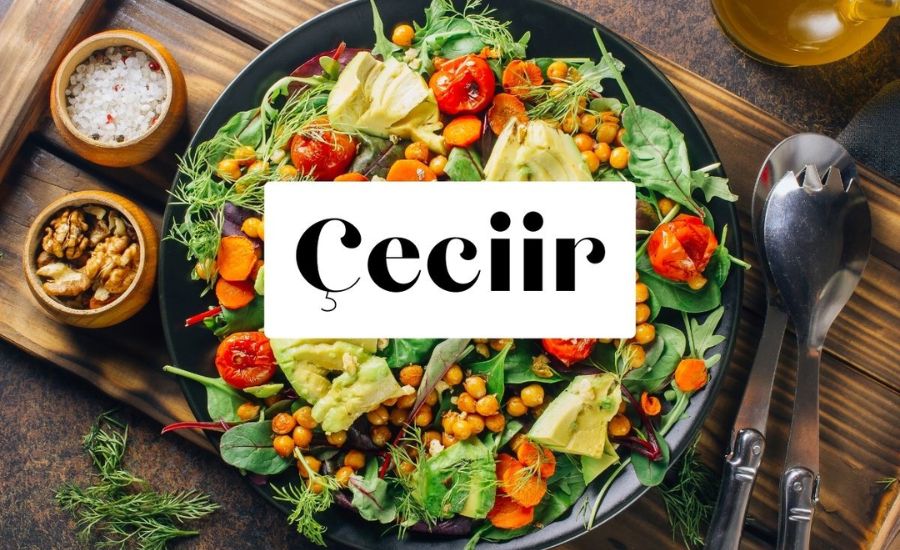Introduction
A classic Turkish stew called Çeciir showcases the modest yet flavorful qualities of chickpeas. Garbanzo beans, tomato paste, garlic, onions, and flavorful spices like cumin and red pepper flakes are the basic ingredients of this dish , which is a favorite throughout Turkey. Çeciir is a popular choice for both home cooks and street vendors because it has a depth of taste that is both healthful and fulfilling, despite being created from basic pantry components.
This stew, which is frequently eaten with rice or bread, is a fantastic vegetarian choice that is also naturally gluten-free, making it an excellent meal for people following special dietary guidelines. The dish’s slow cooking method lets the chickpeas absorb the spices, resulting in a thick, fragrant stew that keeps you warm on chilly days.
Çeciir is a prime illustration of how Turkish cooking honors modest, fresh ingredients and turns them into something genuinely unique with patience, attention to detail, and the ideal proportion of spices. It is still a popular dish in Turkish cuisine, whether it is eaten as a hearty meal or as a cozy snack.
The Origins of Çeciir

The origins of Çeciir can be traced back to the early agricultural civilizations of the Middle East and Central Asia. The dish most likely originated in the fertile crescent, when local populations were sustained mostly by grain production. Despite being historically prepared using wheat, the dish’s distinctive technique and flavor are what really set it apart.
It is possible that the word “Çeciir” is an old word for a particular way of crushing and boiling grains that was intended to make them easier to eat in harsh environments. Effective food preparation and storage were crucial for life in these areas, and Çeciir developed into a dependable and healthful meal choice.
Its remarkable nutritional value and flavorful flavor are the main reasons for its enormous appeal. Rich in proteins and carbs, Çeciir served as a significant energy source for farmers, laborers, and even soldiers during demanding travel or lengthy workdays.
A Glimpse into Turkish Cuisine
Turkish food is a delicious fusion of Central Asian, Middle Eastern, and Mediterranean flavors. The Ottoman Empire’s wide-ranging influence brought together a variety of culinary traditions, resulting in the rich diversity of flavors and ingredients present in Turkish cuisine. Turkish cuisine, from the well-known meze platters to popular street dishes like simit and kebabs, is renowned for its strong flavors and aromatic spices.
Like many other traditional Turkish dishes, Çeciir embodies the essence of Turkish comfort food: it is filling, substantial, and meant to be shared.It is an event designed to unite people, not just a meal. Cesciir has grown to be a popular dish in Turkish cuisine, whether it is offered to guests as a sign of hospitality or enjoyed at the dinner table with family.
Beyond its flavor, çeciir has cultural significance. In Turkey, sharing food is a fundamental aspect of social interaction and a means of showing respect, love, and hospitality. By transforming a simple meal into a meaningful gesture, sharing a bowl of çeciir exemplifies these principles. Dishes like çeciir were traditionally developed to be wholesome, substantial, and able to feed big gatherings in rural and nomadic societies where people depended on what they could farm or gather. These filling stews eventually came to represent coziness, kindness, and community—traditions that are still important in Turkish culture today.
The Traditional Preparation of Çeciir
The traditional base for Çeciir is whole wheat, although depending on the area, you may also find versions that include barley, oats, or even rice. This meal requires a lot of time to prepare; it frequently takes several hours. The wheat grains are soaked first, and then they are boiled until they become tender. After becoming soft, they are either crushed or ground, which gives the dish its unique texture. Depending on local tastes, this texture might be silky and fine or more rustic and coarse.
Following preparation, the grains are seasoned with various herbs, spices, and occasionally meat or vegetables. In addition to enhancing the flavor, these additives transform Çeciir from a straightforward grain-based dish into a filling, substantial dinner. Garlic, onions, cumin, coriander, and occasionally butter or yogurt for extra richness are common components. To make the dish even more tasty and substantial, it is sometimes served with lamb or chicken.
In order to encourage family and friends to get together and share the meal, Çeciir is frequently served in big communal bowls. This communal element of the dish is crucial because it promotes a feeling of community and togetherness, which reflects the value placed on social ties and family in the cultures where Çeciir is consumed.
The History and Origins of Çeciir
The Early History of Çeciir
Although the dish çeciir is regarded as a contemporary invention, its origins can be found in Central Asian stews from antiquity. A main component of the meal, chickpeas have long been a mainstay of Turkish cooking. The ancient Middle Eastern practice of slow-cooked stews, which were intended to serve big gatherings with few ingredients, is probably where the earliest varieties of çeciir originated. These filling meals were designed to be substantial, healthy, and reasonably priced, giving many people something to eat.
Çeciir’s Proliferation throughout the Middle East and Central Asia
Recipes like çeciir started to reach Anatolia from the Middle East as trade routes grew, particularly during the Ottoman Empire’s heyday. Each location added its own twist to the dish as they adjusted to local tastes and the ingredients that were available. The fundamental idea of slow-cooked chickpeas enhanced with tomato paste and seasoned with fragrant tastes persisted, but as regional influences influenced the recipe, new varieties started to appear.
The Value of Culture in Turkish Society
Beyond simply being a hearty dinner, çeciir has a distinct position in Turkish culture. It represents hospitality and familial ties and is closely associated with Turkish culture. The warmth and generosity that characterize Turkish culture are demonstrated by sharing a pot of delicious stew with loved ones. Whether at family get-togethers, religious holidays, or regular meals, çeciir is crucial for uniting people and creating a feeling of community.
Regional Variations of Çeciir
Çeciir has changed over time, with different regions contributing their own distinctive touches, much like many other traditional foods. Every nation has its unique version of the meal, as have individual homes. Just wheat and a few spices are used to make Çeciir in certain regions, while nuts, meats, and vegetables are included in others. While some varieties emphasize a creamy, soothing texture, others are hotter.
Turkey: Cracked wheat that has been softened and mixed with meat and veggies is a common ingredient in Çeciir. It is usually offered for lunch or dinner as the main entrée. Depending on the location, the Turkish version may be seasoned with allspice, paprika, or cinnamon.
Central Asia: Çeciir has a savory flavor and is typically served with beef or mutton in Central Asian nations like Kazakhstan and Uzbekistan. It is frequently prepared with vegetables like tomatoes, onions, and carrots, which give the meal a substantial and satisfying texture.
Middle East: Çeciir is frequently flavored with saffron, turmeric, and dried fruits like raisins or apricots in countries like Iran and Iraq. These components contribute a harmony of sweet and savory flavors, resulting in a flavor that is deep and nuanced.
The fundamental elements of Çeciir—a filling, grain-based dish that honors common cultural traditions and unites people—remain the same despite these regional variations in ingredients and flavors.
Ingredients and Preparation of Çeciir
The simplicity of çeciir and its capacity to produce hearty, comforting flavors with only a few basic ingredients are what make it so appealing. The main ingredients of this traditional Turkish stew are chickpeas,or garbanzo beans, tomato paste, onions, garlic, and a mixture of spices. Usually, the components are sautéed in olive oil, which creates the delicious, aromatic foundation for the stew. Red pepper flakes, cumin, and bay leaves are common seasonings that give the dish its distinct depth of flavor and warmth.
Step-by-Step Guide to Making Çeciir
Although it takes some time for the tastes to emerge, making çeciir is a simple operation. To make it, follow these steps:
Start by letting the chickpeas soak for the entire night. This makes them softer so they cook more evenly and take in all the delicious flavors when cooking the stew.
Cook the Aromatics: In a big saucepan, heat up some olive oil. To create a tasty base, sauté the garlic and onions until they are tender and exude their aromatic scents.
Add Spices and Tomato Paste: Add the spices of your choice and the tomato paste. In order to enhance the flavors and give the meal more depth, let the mixture cook for a few minutes.
Add the soaked chickpeas and enough water to cover them in order to simmer them. Reduce the heat and simmer the stew for approximately one to two hours, or until the flavors are thoroughly combined and the chickpeas are soft.
Adjust and Serve: To add brightness to the stew, taste it and adjust the ingredients with salt, pepper, and a squeeze of lemon juice. For a full, substantial dinner, serve with bread or rice on the side and garnish with fresh parsley.
Ingredient Variations by Region
Regional variations exist in çeciir, as is the case with other traditional foods. In order to improve the stew’s texture and flavor, folks in Southern Turkey may add vegetables like potatoes or carrots. For added creaminess and richness, it is customary in various areas to garnish the dish with a dollop of yogurt or crumbled feta cheese. The essence of çeciir—a hearty, filling dish that unites people—remains the same despite these regional variations that showcase regional tastes and the availability of seasonal ingredients.
The Nutritional Benefits of Çeciir
In addition to its cultural significance and lengthy history, Çeciir is prized for its remarkable nutritional value.Because it is made with whole grains like rice, wheat, or barley, it is high in dietary fiber, which aids in blood sugar regulation and encourages healthy digestion. Iron, magnesium, and B vitamins are just a few of the vital minerals that are abundant in the grains used in çeciir and promote general health.
Ceciir becomes a well-rounded meal when cooked with meat and vegetables, providing a balance of protein, good fats, and extra vitamins and antioxidants. The dish’s anti-inflammatory and immune-boosting qualities are further enhanced by the use of garlic, onions, and spices like cumin and red pepper flakes.
Essentially, çeciir is a filling, healthy food that contributes both cultural diversity and nutritional value to the table. It is more than just a tasty and cozy stew. With its comforting satisfaction and health benefits, it is no wonder that this meal is still a mainstay in many homes around the world.
Çeciir Around the World

Despite its strong Turkish roots, Çeciir has become more and more well-liked throughout the world, especially among people who eat vegetarian Turkish food or adhere to the Mediterranean diet. It has been accepted and incorporated into regional culinary customs throughout the Middle East and Central Asia. Each country’s version of çeciir reflects its particular culture, such as Greece, Lebanon, and Syria, where chickpeas are also a staple in stews and other meals.
Chickpeas, tomato paste, olive oil, and spices are the staples of çeciir, and they have impacted many different cuisines around the world. It is quite similar to Mediterranean chickpea stews, which are hearty and warming recipes made using garbanzo beans as the base. As more people look for plant-based substitutes for conventional meat-heavy meals, çeciir has inspired the emergence of vegan and gluten-free chickpea stews in the US and parts of Europe.
Both home cooks and professional chefs are experimenting with the meal and adding their own touches as çeciir continues to garner international attention. While some variations include yogurt or coconut milk for a creamier texture, others add spices like turmeric or harissa to give the stew new tastes. These modifications enable çeciir to develop and satisfy palates worldwide while preserving its core qualities.
Facts:
- Origin and History: Çeciir is a traditional Turkish stew with roots in ancient Middle Eastern and Central Asian cooking. It originated in the fertile crescent, where grains like wheat were staple food for early agricultural societies. The dish has evolved over centuries, gaining regional variations along the way.
- Main Ingredients: The base ingredients of çeciir are chickpeas (garbanzo beans), tomato paste, olive oil, garlic, onions, and a mix of spices such as cumin, red pepper flakes, and bay leaves. It is usually served with rice or bread.
- Nutritional Value: Çeciir is a healthy and nutritious dish rich in protein, fiber, and essential minerals like iron, magnesium, and B vitamins. The use of whole grains and vegetables makes it a well-rounded meal. It is naturally gluten-free and a good option for plant-based diets.
- Cultural Significance: Çeciir plays a major role in Turkish culture as a symbol of hospitality and family. It is traditionally shared among family and friends and represents a gesture of warmth and community.
- Regional Variations: While çeciir originated in Turkey, it has spread to various parts of the world, including the Middle East, Central Asia, and Europe. Each region adds its unique spin, incorporating different spices, vegetables, and sometimes meat.
- Health Benefits: The dish offers various health benefits, including promoting healthy digestion due to its high fiber content. Garlic, onions, and spices like cumin and red pepper flakes provide anti-inflammatory and immune-boosting properties.
Summary:
Çeciir is a beloved Turkish stew that showcases the rich flavors of chickpeas combined with aromatic spices and vegetables. It is a simple, hearty dish made with basic pantry ingredients like chickpeas, tomato paste, garlic, onions, and spices such as cumin and red pepper flakes. This stew holds significant cultural value in Turkey, symbolizing hospitality, community, and family.
Historically, Çeciir traces its roots to early agricultural societies in the Middle East and Central Asia, where it was a staple for providing energy and nourishment. Its popularity has spread globally, influencing various culinary traditions in the Middle East, Central Asia, and beyond. Regional variations have emerged, with different countries adding their unique ingredients and flavors to the dish.
In addition to its cultural and historical importance, Çeciir is also a nutritious, filling meal. The use of whole grains, chickpeas, and vegetables provides a good source of protein, fiber, and essential minerals, while its comforting nature makes it a popular choice for cold days. As plant-based diets become more popular globally, Çeciir has inspired many vegan and gluten-free adaptations.
FAQs:
- What is Çeciir? Çeciir is a traditional Turkish stew made with chickpeas, tomato paste, garlic, onions, and a variety of spices like cumin and red pepper flakes. It is a hearty, vegetarian dish commonly served with rice or bread.
- Where did Çeciir originate? Çeciir has roots in the Middle East and Central Asia, specifically in the fertile crescent, and is a staple in Turkish cuisine. It has evolved over time as it spread to different regions.
- What are the health benefits of Çeciir? Çeciir is rich in fiber, protein, and essential minerals like iron and magnesium. It is also anti-inflammatory, thanks to ingredients like garlic, onions, and spices such as cumin and red pepper flakes. It is naturally gluten-free and a great option for plant-based diets.
- Can Çeciir be made vegan? Yes, Çeciir is naturally a vegetarian dish. By omitting any meat and using plant-based ingredients like olive oil, it can easily be made vegan.
- What are some regional variations of Çeciir? In Turkey, Çeciir may be made with cracked wheat, meat, and vegetables. In Central Asia, it is often prepared with beef or mutton and vegetables like tomatoes, onions, and carrots. In the Middle East, it is sometimes flavored with saffron, turmeric, or dried fruits like raisins and apricots.
- How do I make Çeciir at home? To make Çeciir, start by soaking chickpeas overnight. Sauté garlic and onions in olive oil, then add spices and tomato paste. Add the soaked chickpeas, cover with water, and simmer for 1-2 hours until the flavors meld and the chickpeas are tender. Serve with rice or bread and garnish with fresh parsley.
- Is Çeciir gluten-free? Yes, Çeciir is naturally gluten-free as it is made with chickpeas and other gluten-free grains, making it a great option for those with gluten sensitivities.
Read More information About that Food At Provibes
